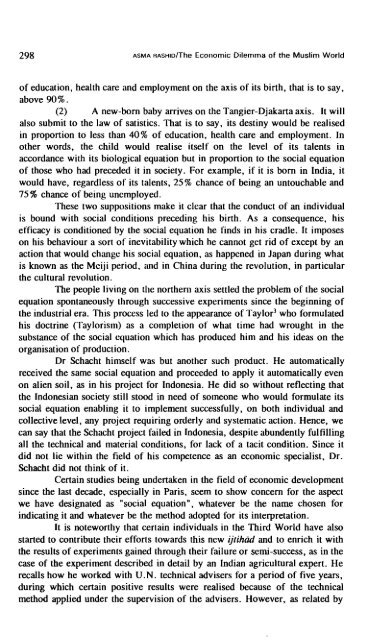THE ECONOMIC DILEMMA OF THE MUSLIM WORLD
THE ECONOMIC DILEMMA OF THE MUSLIM WORLD
THE ECONOMIC DILEMMA OF THE MUSLIM WORLD
Create successful ePaper yourself
Turn your PDF publications into a flip-book with our unique Google optimized e-Paper software.
298 ASMA RASHIDIT~~ Economic Dilemma of the Muslim World<br />
of education, health care and employment on the axis of its birth, that is to say.<br />
above 90 % .<br />
(2) A new-born baby arrives on the Tangier-Djakarta axis. It will<br />
also submit to the law of satistics. That is to say, its destiny would be realised<br />
in proportion to less than 40% of education, health care and employment. In<br />
other words, the child would realise itself on the level of its talents in<br />
accordance with its biological equation but in proportion to the social equation<br />
of those who had preceded it in society. For example, if it is born in India, it<br />
would have, regardless of its talents, 25% chance of being an untouchable and<br />
75 % chance of being unemployed.<br />
These two suppositions make it clear that the conduct of an individual<br />
is bound with social conditions preceding his birth. As a consequence, his<br />
efficacy is conditioned by the social equation he finds in his cradle. It imposes<br />
on his behaviour a sort of inevitability which he cannot get rid of except by an<br />
action that would change his social equation, as happcned in Japan during what<br />
is known as the Mciji period, and in China during the revolution, in particular<br />
the cultural revolution.<br />
The people living on the northern axis settled the problem of the social<br />
equation spontaneously through successive experiments since the beginning of<br />
the industrial era. This process led to the appearance of Taylor3 who formulated<br />
his doctrine (Taylorism) as a completion of what time had wrought in the<br />
substance of the social equation which has produced him and his ideas on the<br />
organisation of production.<br />
Dr Schacht himself was but another such product. He automatically<br />
received the same social equation and proceeded to apply it automatically even<br />
on alien soil, as in his project for Indonesia. He did so without reflecting that<br />
the Indonesian society still stood in need of someone who would formulate its<br />
social equation enabling it to implement successfully, on both individual and<br />
collective level, any project requiring orderly and systematic action. Hence, we<br />
can say that the Schacht project failed in Indonesia, despite abundently fulfilling<br />
all the technical and material conditions, for lack of a tacit condition. Since it<br />
did not lie within the field of his competence as an economic specialist, Dr.<br />
Schacht did not think of it.<br />
Certain studies being undertaken in the field of economic development<br />
since the last decade, especially in Paris, scem to show concern for the aspect<br />
we have designated as "social equation", whatever be the name chosen for<br />
indicating it and whatever be the method adopted for its interpretation.<br />
It is noteworthy that certain individuals in the Third World have also<br />
started to contribute their efforts towards this new ijlihod and to enrich it with<br />
the results of experiments gained through their failure or semi-success, as in the<br />
case of the experiment described in detail by an Indian agricultural expert. He<br />
recalls how he worked with U.N. technical advisers for a period of five years,<br />
during which certain positive results were realised because of the technical<br />
method applied under the supervision of the advisers. However, as related by
















